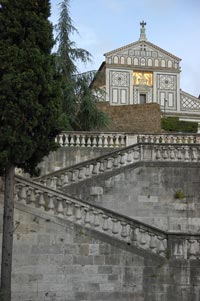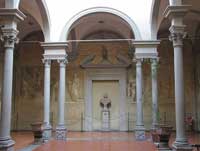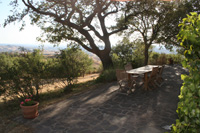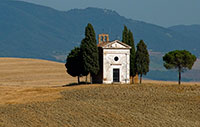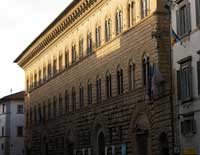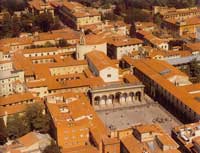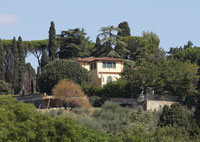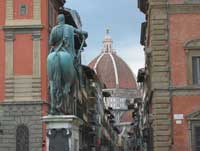| |
|
1
The walk starts in the via Giuseppe Verdi, a narrow street tucked away in the south-east corner of the main square. The narrow picturesque Via Giuseppe Verdi leads steeply uphill, and you will see a red and white stripe painted on the wall at the corner of the street. (This is the sign of the Club Alpino Italiano or CAI, which is responsible for way-marking so many of the walks in Italy). The red and white stripes are intended as an aid to walkers and are painted on walls, trees and rocks. The via Giuseppe Verdi climbs quite steeply for about two to three hundred yards before reaching a fork and the first of many panoramic views.
2
Take the via Montececeri, the start of which is marked by a plaque to the famous American architect, Frank Lloyd Wright, who lived here in 1910. He was preparing his Wasmuth porllolio at that time.(Wright had left his wife and children for Mamah Cheney, herself the wife of a client, and together they set up house in Fiesole. The plaimetric configuration of this house inspired the design and creation of the famed Taliesin in Wisconsin.
Frank Lloyd Wright (1867-1959) is considered by many to be one of the 20th
century's finest and most prolific architects. In 2010, Fiesole celebrated the centenary of Frank Lloyd Wright’s stay in Fiesole and the influence of his organic architecture on the Florentine School). In his house in Fiesole, Wright worked on several projects for a house in the area, but they never made it off the drawing board. [2]
The road climbs steeply for a few hundred yards before reaching another fork. The name of the via Montececeriis due to the presence of swans in this area. They have an excrescence on their beaks that more or less resembles a hickpea (or cece in italian). This area is famous because Leonardo da Vinci first attempted the first flight ever, in 1506.
3
Take the via degli Scalpellini (the stonecutter's road), which leads downhill past a sign for the Parco di Montececeri. The road soon bears to the right and becomes a track, which leads into a wood. Monte Ceceri (414 metres above sea level) is recalled by Leonardo in the "Codex on the flight of birds" in relation to his prophecy on human flight: «The great bird will take its first flight from the back of Monte Cecero, filling the universe with stupor, filling all writings with its fame and bringing glory to the nest in which it was born». Legend has it that the flight attempted by Zoroastro, taking off from this hill, ended in a disastrous fall. [1]
4
The path we want to follow steers a route between several other paths, all marked with no entry signs. You will soon come to a sign offering you the choice of two directions, A&C. Follow C and turn to the right. The path runs downhill to the Braschi Quarry. Monte Ceceri is riddled with quarries, which, for centuries, supplied the stone for so many Florentine palazzi.
5
Don’t worry about the sign and take the road marked Pericolo Caduta Massi, which climbs steeply uphill. In time, the path will start to go downhill and you will notice that the distant drone of Florence’s traffic has started to fade. Very soon the trees will thin out and you will enjoy wonderful views of the surrounding countryside. Continue downhill until you come to another fork. Turn left and walk until you reach a proper set of wooden signposts.
6
Take the path signposted to Borgunto and you will soon see a small group of houses on your right. Follow the path in the direction of the houses and you will come out into a small car park. Look out for the small chapel with its beautiful terracotta tiled dome.
7
Turn right by the chapel onto a tarmac road, which is signposted to Settignano and Compiobbi. Follow the road downhill until it meets a more major road. Turn right and walk for about 250 yards, past two electricity pylons, until you reach a bus stop and a small car park. On the opposite side of the road sits the Villa dei Bosconi.
8
At the end of the car park, behind some large rocks, lies a path, which leads down through the trees. After about five minutes the path will come to a tarmac road. Turn right and after about 50 yards you will see a wooden signpost. Continue walking in the direction of Settignano.
9
After another few hundred yards you will see, on your left and in front of an empty shrine, another signpost pointing to Settignano. This stretch of the route is reasonably well marked. Walk through the olive groves, across a bridge and up through the trees, always keeping an eye open for the red and white stripes.
10
The path will finally come to a low wall, on the other side of which runs a narrow, but often busy, road. Turn right and walk along the road for a few minutes until you reach a fork. At this point, bear right in the direction of Vincigliata. After about 100 yards you will see, on your right, an entrance to the Castel del Poggio.
11
On the opposite side of the road a path follows a steep and rocky descent through the woods.After about ten minutes the path opens out into an olive grove. At the bottom of the field there is a wooden signpost on the left. Follow the directions for Settignano. After another rocky, if shorter, descent the path meets a tarmac road where you have two options.
Directly ahead the road leads past the cemetery to the centre of Settignano, where you can grab a bite to eat before catching the number 10 bus back to Florence. You can choose between several cafes, a pizzeria and a chichi, if rather pricey, Enoteca, La Sosta del Rossellino. (If you like Renaissance gardens, you might like to delay your return and visit the 16th century Villa Gamberaia, which is a short walk along the via del Rossellino).
The alternative is to turn right and follow the quiet and relatively traffic-free road all the way down the hill to the tiny hamlet of Ponte a Mensola. At the bottom of the road, turn left and then right and you will come to the little restaurant of Osvaldo, which has been serving traditional Tuscan food here for half a century.
A short distance beyond the restaurant, you can catch the number 10 bus back to Florence.
Tattoria Osvaldo | Via G. D'Annunzio 51/r - 50136 Ponte a Mensola - Firenze
www.trattoriaosvaldo.it
The building which has housed Tattoria Osvaldo for more than 50 years and the wine shop before that has a long history, dating back to the early years of the fifteenth century, when it was a monastery. On the interior of the Trattoria, in fact, one can admire frescoes and various other historic remains.
In time, the structure became a tavern and wine shop. Beneath an arbor where a beautiful well was located, people would gather to restore their spirits with food and drink and to rest their horses before undertaking the climb to Settignano. The neighborhood has been home to some world-renown figures over the years, including Michelangelo, Gabriele d’Annunzio, Eleonora Duse, Mark Twain, etc.
|
|

Villa Medici in Fiesole, lower garden
In the Renaissance many noble families chose to have their countryside residences built on this hill. Nowadays in Fiesole there are over 30 villas - elegant buildings surrounded by well-tended luxuriant gardens.
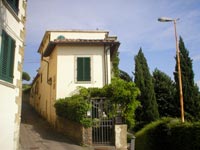 Frank Lloyd Wright’s house in Fiesole Frank Lloyd Wright’s house in Fiesole
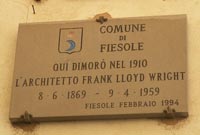
 Settignano from Corbignano Settignano from Corbignano
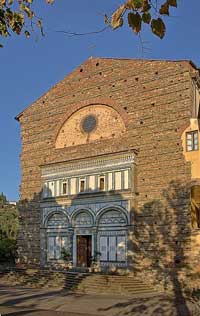
The Badia or ancient cathedral of St. Romulus, built in 1028 by Bishop Jacopo Bavaro with materials taken from several older edifices, at the foot of the hill on which Fiesole stands, supposed to cover the site of the martyrdom of St. Romulus; it contains notable sculptures by Mino da Fiesole. The old cathedral became a Benedictine abbey, which passed into the hands of the regular canons of Lateran. It once possessed a valuable library, long since dispersed. The abbey was closed in 1778.
|

[0] Fiesole was probably founded in the 9th-8th century BC, as it was an important member of the Etruscan confederacy, as may be seen from the remains of its ancient walls.
The first recorded mention on the town dates to 283 BC, when the town, then known as Faesulae, was conquered by the Romans. In pagan antiquity it was the seat of a famous school of augurs, and every year twelve young men were sent thither from Rome to study the art of divination. Sulla colonized it with veterans, who afterwards, under the leadership of Gaius Mallius, supported the cause of Catilina.[1][2]
Fiesole was the scene of Stilicho's great victory over the Germanic hordes of the Vandals and Suevi under Radagaisus in 406.[3] During the Gothic War (536-53) the town was several times besieged. In 539 Justinus, the Byzantine general, captured it and razed its fortifications.
It was an independent town for several centuries in the early Middle Ages, no less powerful than Florence in the valley below, and many wars arose between them; in 1010 and 1025 Fiesole was sacked by the Florentines, before it was conquered by Florence in 1125, and its leading families obliged to take up their residence in Florence.
By the 14th century, rich Florentines had countryside villas in Fiesole, and one of them is the setting of the frame narrative of the Decameron, also Boccaccio wrote the poem "Ninfale fiesolano". Robert Browning also mentions "sober pleasant Fiesole" several times in his poem, Andrea del Sarto.
[1] The quarries of Fiesole, and of Maiano in particular, exploited until the early 20th century, are famous for their sandstone, the so-called "pietra fiesolana", amply utilised by sculptors since the 15th century. Mentioned by Benvenuto Cellini and Giorgio Vasari, "pietra fiesolana" was most suitable for architectural works and monuments, as well as for more or less refined elements used for civil, religious and urban furnishings. It was so widely used that the Medicean government had to exert a severe policy of control over its exploitation. In the 17th and 18th centuries, in fact, the Fiesole quarries were "banned" and reserved exclusively to Florentine monuments. Among the last works built with "pietra fiesolana" are the columns in the courtyard, the stairway and other architectural elements of the Florence National Central Library. Today the area has become a park, along whose itineraries can be seen the basic features of the ancient quarries: the cut, the open-sky, and the stone quarry "cava ficcata", artificial caves supported by feet.
Montececeri is a "Leonardian place". In a clearing on the top of the hill, a stele bears the prop hecy of flight from "Monte del Cigno" (Montececeri) noted by Leonardo on the inner cover of the "Codex on the Flight of Birds" now in the Royal Library of Turin.
Leonardo also mentions "Monte Ceceri" in drawing the contour of the hills around Florence on Folio 20v of tMadrid Ms. II.
In the vicinity of the Il Regresso curve, along the provincial road that links Fiesole to Florence, a plate on the wall of Villa La Torrossa recalls that Leonardo da Vinci decided to attempt human flight here, from Montececeri. Legend has it that Zoroastro da Peretola (the illegitimate son of one of the Rucellai, a pupil of Leonardo in Milan and in Florence, during the period of the wall painting depicting the Battle of Anghiari, who later died in Rome and is recalled as an esoteric personage) attempted to fly from Montececeri, ending in a disastrous fall.
[Source: Parco di Montececeri - Cave di Maiano | www. brunelleschi.imss.fi.it]
|
[2] In 1903, Wright designed a house for Edwin Cheney, a neighbor in Oak Park, and immediately took a liking to Cheney's wife, Mamah Borthwick Cheney. Mamah Cheney was a modern woman with interests outside the home. She was an early feminist and Wright viewed her as his intellectual equal. The two fell in love, even though Wright had been married for almost 20 years.
Often the two could be seen taking rides in Wright's automobile through Oak Park, and they became the talk of the town. Wright's wife, Kitty, sure that this attachment would fade as the others had, refused to grant him a divorce. Neither would Edwin Cheney grant one to Mamah. In 1909, even before the Robie House was completed, Wright and Mamah Cheney went together to Europe, leaving their own spouses and children behind. The scandal that erupted virtually destroyed Wright's ability to practice architecture in the United States.
Architectural historians have speculated on why Wright decided to turn his life upside-down. Scholars argue that he felt by 1907-8 that he had done every thing he could do with the Prairie Style, particularly from the standpoint of the one-family house. Wright was not getting larger commissions for commercial or public buildings, which frustrated him as it would any highly skilled architect.
Wright and Mamah Cheney traveled extensively throughout Europe. In 1910, during a stop in Berlin, Wright, with virtually all of his drawings, visited the publishing house of Ernst Wasmuth, who had agreed to publish his work there. In two volumes, the Wasmuth Portfolio was thus published, and created the first major exposure of Wright's work in Europe. The later Bauhaus movement's founders claimed to have been inspired by these books. Wright remained in Europe for one year (though Mamah Cheney returned to the United States a few times) and set up home in Fiesole, Italy. During this time, Edwin Cheney granted her a divorce, though Kitty again refused to grant one to her husband.
Wright’s innovations themselves left a deep impression on the Florentine school of architecture of the time, in particular on Rolando Paganini, Leonardo Ricci, Leonardo Savioli, Franco Bonaiuti and Giovanni Michelucci.
Wright remained in Europe for almost one year and set up home first in Florence, Italy and later in Fiesole, Italy.
After Wright's return to the United States in October 1910, Wright persuaded his mother to buy land for him in Spring Green, Wisconsin. The land, bought on April 10, 1911, was adjacent to land held by his mother's family, the Lloyd-Joneses. Wright began to build himself a new home, which he called Taliesin, by May 1911.
|
|
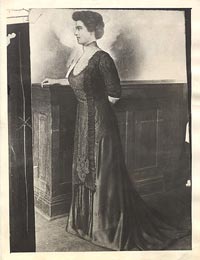
The only known photograph of Mamah Borthwick Cheney, published in the Chicago Tribune at the time of her murder, in 1914. |
|
|


